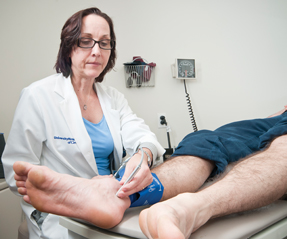Blueprint reveals clinical slant to upcoming genomics research
The 10th anniversary of the publication of the entire sequenced human genome is celebrated with another publication, this time of clinical applications for the research. Not only can diseases be treated, but better drugs and streamlined clinical trials may result.
The 10-year anniversary of the publication of the sequence of the human genome offers primary care physicians a look into how they can incorporate genomic advances into clinical care in the next decade.
The National Institutes of Health celebrated the 10th anniversary of the publication of the sequence of the human genome and the subsequent remarkable burst of scientific and clinical discovery at a symposium Feb. 11. (Speaker videos and slides from the symposium are online.) Fittingly, the National Human Genome Research Institute took the opportunity to unveil its long-awaited blueprint for genomics research, published in Nature on Feb. 10, is online.

A product of over two years of dialogue within and outside of the genomics community, the blueprint, called “Charting a course for genomic medicine from base pairs to bedside,” provides a glimpse into the next decade of genomics research. This new strategic vision has a considerably more clinical slant than its 2003 predecessor, reflecting the growing confluence of genomics research, clinical research and clinical care.
The blueprint paints a picture of the rate at which genomic discoveries will yield proven clinical applications for many conditions. The progression of genomic science is broken into five overlapping phases:
- 1. understanding the structure of genomes,
- 2. understanding the biology of genomes,
- 3. understanding the biology of disease,
- 4. advancing the science of medicine and
- 5. improving the effectiveness of health care.
These phases are predicated on the increasing ability to develop diagnostics and treatments based on fundamental biological insights driven by genomic sciences. Currently, the majority of genomics research is in phases 1-3, but over the next 10 years the blueprint predicts a gradual shift to phases 2-4, and beyond 10 years to phases 2-5. The blueprint portrays non-linear advances, with clinical advances coming to health care on an ongoing basis.
Over this time period, five general imperatives for genomic medicine are identified, including:
- 1. making genomics-based diagnostics routine,
- 2. defining the genetic components of disease,
- 3. comprehensively characterizing cancer genomes,
- 4. developing practical systems for clinical genomics informatics, and
- 5. defining the role of the human microbiome in health and disease.
The document advances a powerful argument that much remains to be learned about the fundamental biology of genomes. This biology can best be revealed by comprehensive analysis of genomes from many individuals as well as a diversity of other organisms.
Though new sequencing technologies have turbocharged these efforts, understanding the fundamental biology of genomes requires creating new approaches for high throughput measurement of the epigenome, proteome, and RNA molecules of a wide variety of cell types in a wide variety of states. These technologies require developing large numbers of “affinity reagents,” antibodies for example, and new techniques need to be developed to facilitate studies on small numbers of cells of small samples.
In the area of biology of disease, similar scientific resources will need to be brought to bear. A pressing and very feasible near-term priority is the elucidation of the spectrum of primary sequence variations underpinning the remaining uncharacterized Mendelian conditions, of which there are several thousand.
Somatic variation in cancer has been shown by projects like the Cancer Genome Atlas to be immensely complicated, and working out these complexities will require time and innovation. Already, genome-wide association studies have provided a remarkable wealth of new information about common, complex conditions such as coronary artery disease and type 2 diabetes.
However, much remains to be learned about variations aside from common single nucleotide polymorphisms that are associated with disease. Sequencing costs are no longer the prohibitive bottleneck to understanding human genetic variation that they were five years ago. That bottleneck is now the collection and preparation of accurately phenotyped samples, as well as data analysis for large numbers of individuals.
Another looming challenge—made easier by comprehensive catalogs of normal variation—will be determining the causality of variations detected in association studies of affected and control subjects, particularly in the setting of complex disease. Perhaps the biggest hurdle will be the massive amount of work, much of it rooted in old-fashioned biochemistry and cell biology, needed to determine the function of genes and their related pathways in normal as well as disease states. This work can be facilitated by the development of libraries of chemical probes (amounting to smart bombs) that interact with proteins and possibly functional RNA molecules in highly specific ways to disrupt function.
Optimizing such small molecules for potential use as drugs in systematic and cost-effective ways will facilitate preclinical and clinical trials needed to bring new therapies to the bedside. Some of the groundwork for this is being laid with the proposed creation of the National Center for Advancing Translational Sciences, details of which are available online.
Importantly, the new blueprint for the future of genomics articulates a clear call for the generation of evidence of clinical utility for new genomic health applications. In particular, there is a need to develop novel methods for clinical trial design to circumvent the prohibitive expense of gathering large numbers of individuals with similar genotypic profiles for traditional trials.
The argument is made that prospective randomized clinical trials, though often the ideal, will in many cases not be feasible, and that genomics research will necessarily have to intersect with electronic health record systems. As I have written recently, new informatics applications will be required to effectively analyze the volumes of data from the resulting studies. Likewise, electronic health records will need to become genome-enabled in order to effectively store, analyze and help clinicians make use of genomic data. Clinicians will also need to become more genome-enabled, likely through electronic clinical decision support systems.
Finally, the blueprint for genomics research highlights the increasing importance of addressing issues at the intersection of genomics and society. Widespread appropriate use of genomic advances will require that clinicians, patients and policymakers all be educated sufficiently to understand the potential benefits and harms that come with these advances.
Likewise, public policymakers require sound science that addresses issues of law, ethics and health service delivery that are increasingly raised by new genomic applications. In the end, these issues will be as important as the basic science in realizing the benefits of genomic advances in the decades to come.




